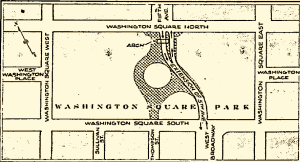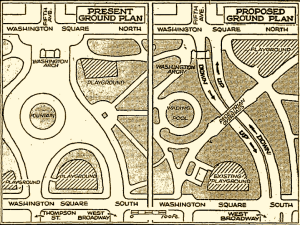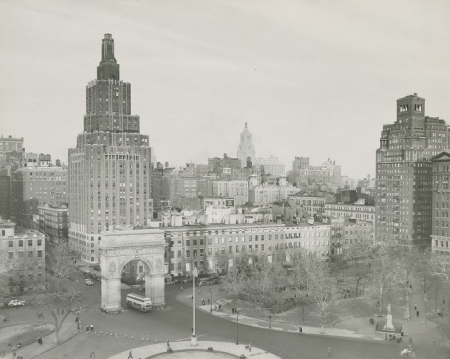The history of New York City is littered with never-realized proposals: moving sidewalks, a burial ground in Central Park, and these 100-story apartment houses meant for Harlem.
Another half-baked idea that (luckily) never got off the ground was a plan for a highway running through Washington Square Park, proposed many times through the 1950s by “master builder” Robert Moses.
 As Parks Commissioner in 1940, Moses originally wanted to build a “double highway” snaking along the side of Washington Square Park (left).
As Parks Commissioner in 1940, Moses originally wanted to build a “double highway” snaking along the side of Washington Square Park (left).
At the time, a narrow roadway let vehicles go south from Fifth Avenue to Washington Square South (above, in 1950).
That double highway was shot down thanks to opposition from local residents, business owners, and NYU officials. But Moses wasn’t giving up so easily.
 In the early 1950s, he proposed bisecting the park with a 48-foot-wide highway connecting Fifth Avenue to West Broadway—which would be widened and illustriously renamed Fifth Avenue South.
In the early 1950s, he proposed bisecting the park with a 48-foot-wide highway connecting Fifth Avenue to West Broadway—which would be widened and illustriously renamed Fifth Avenue South.
Naturally community leaders were outraged. In 1955, plans were submitted for a “depressed, four-lane highway running through the park in an open cut from Fifth Avenue under the Washington Arch,” wrote The New York Times.
 “Mothers and children, New York University students and others who use the park would be able to cross from one half of the park to the other by a foot-bridge thirty-six feet wide.”
“Mothers and children, New York University students and others who use the park would be able to cross from one half of the park to the other by a foot-bridge thirty-six feet wide.”
Again, opposition was fierce. Jane Jacobs led the fight, with Eleanor Roosevelt and Lewis Mumford in her corner.
They were fighting not only the Washington Square Highway plan but another Moses’ idea to raze 14 blocks of prime Greenwich Village real estate and build a series of apartment complexes.
By the end of the decade, Moses retreated. Washington Square Park has been remodeled and revamped, but at least it’s not crisscrossed by a superhighway.
[Photos: the Square in the 1950s and 1960s, New York University Archives]


